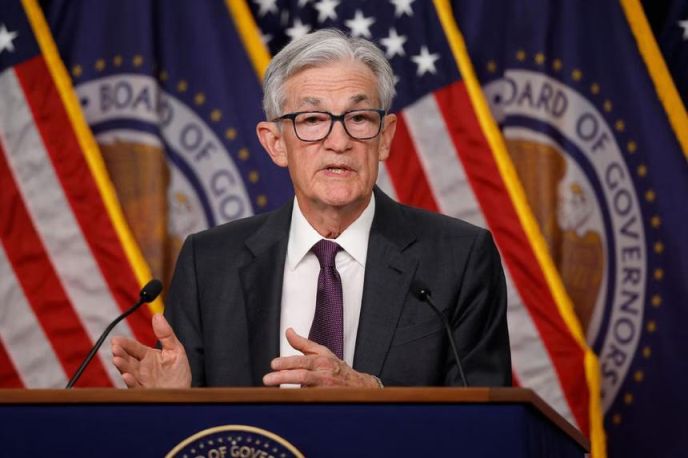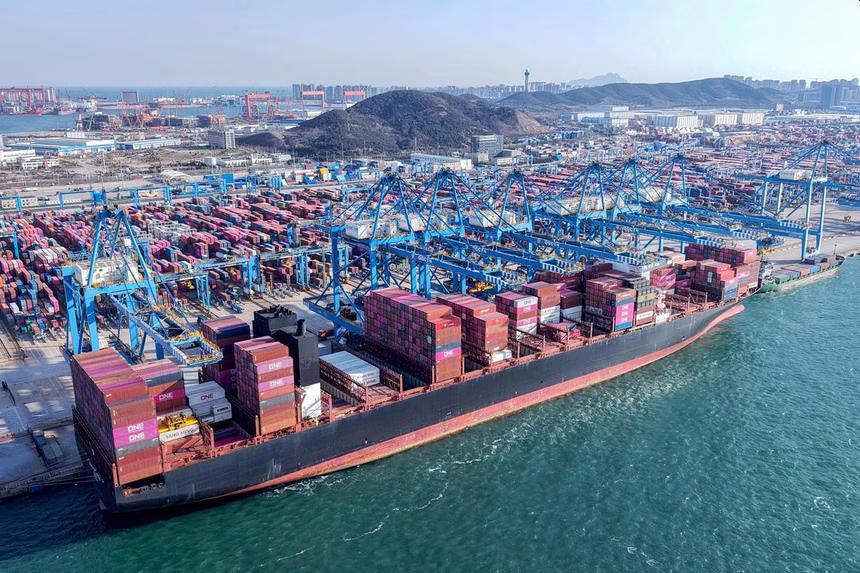By Eric Vandenbroeck and co-workers
Trump Tariff Tailspin Worsens
President Donald
Trump’s new tariffs are “larger than expected,” and the economic
fallout, including higher inflation and slower growth, likely will be as well,
Federal Reserve Chair Jerome Powell said on April 4 in remarks that pointed to
the potentially tricky set of decisions ahead for the central bank.
“We face a highly
uncertain outlook with elevated risks of both higher unemployment and higher
inflation,” undermining both of the Fed’s mandates of 2 percent inflation and
maximum employment, Powell told told a business
journalists’ conference in Arlington, Virginia. These remarks pointed to
difficult decisions ahead for the US central bank and did nothing to staunch
global bloodletting in stock markets.
Powell spoke as
equity markets from Tokyo to London to New York continued a
swoon that has wiped some 10 percent off major US stock indexes
since Trump announced a raft of new tariffs on trading partners around the
world on April 2.
Investors had looked
to Powell’s speech for reassurance that perhaps the Fed was poised to take
supportive actions as it has in previous moments of extreme market duress, and
Trump himself took to his social media platform to say now would be the
“perfect time” for the Fed to cut interest rates.
But Powell did not
address the sell-off directly, instead acknowledging that the Fed faced the
same uncertainty engulfing investors and company executives.
Wall Street nosedived
for a second straight day on April 4, confirming the Nasdaq Composite was in a
bear market and the Dow Jones Industrial Average was in a correction, as an
escalating global trade war spurred the biggest losses since the pandemic.
The Dow Jones
Industrial Average, S&P 500, and Nasdaq Composite posted their largest
two-day declines since the emerging coronavirus caused global panic during U.S.
President Donald Trump’s first term. For April 3 and April 4, the Dow was down
9.3 per cent, the S&P 500 10.5 per cent and the Nasdaq 11.4 per cent.
Fallout from
Trump’s sweeping tariffs stoked fears of a global recession, wiping
trillions of dollars of value from US companies. Highlighting growing panic
among investors, the CBOE Volatility Index, or Wall Street’s fear gauge, closed
at its highest level since April 2020.
Since late on April
2, when Trump boosted tariff barriers to
their highest level in more than a century, investors have dumped stocks,
fearing both the new US economic reality and also how US trading partners might
retaliate by steepening their trade barriers.
The Nasdaq slid on
April 4, 962.82 points, or 5.82 percent, to 15,587.79, confirming the
tech-heavy index was in a bear market compared to its record closing high of
20,173.89 on Dec 16.
Meanwhile, the Dow
Jones Industrial Average fell 2,231.07 points, or 5.50 percent, to 38,314.86
points, confirming a correction to its record closing high of 45,014.04 on
December 4.
The S&P 500 lost
322.44 points, or 5.97 percent, to close at 5,074.08 points, its lowest finish
in 11 months.
“Right now, how bad
it gets depends on how committed the administration is to this set of policies
which the market is voting against,” said Steve Sosnick, chief strategist at
Interactive Brokers.

US Federal Reserve
chair Jerome Powell used a once-abandoned term to say the inflationary impact
of tariffs was likely to be transitory, which was surprising to analysts.
Global governments
began reacting to Trump’s tariff announcement on April 4, further undermining
investor sentiment that a global recession could be averted. JP Morgan said it
was forecasting a 60 per cent chance of the global economy entering a recession
by year-end, up from 40 per cent previously.
China’s finance
ministry said it would impose additional tariffs of 34 percent on all
US goods from April 10. Meanwhile, the prime ministers of Britain, Australia,
and Italy held talks on how to respond to Trump’s tariff salvo.
“We’re in the Wild
West of a trade war right now,” said Mariam Adams, managing director at
UBS Wealth Management.
Safe-haven buying in
the bond market sent the yield on the benchmark 10-year Treasury notes to below
4 per cent.
This pushed US bank
stocks down further, with the sector under pressure globally, as the prospect
of interest rate cuts from central banks and a hit to economic growth from
tariffs would crimp profitability. The S&P Banks index dropped 7.3 per
cent.
All 11 S&P
sectors dropped by more than 4.5 per cent, with energy the leading laggard for
the second straight day, off 8.7 per cent, as companies tracked a 7.3 per cent
decline in US crude prices.
US-listed shares of
Chinese companies dived, with JD.com, Alibaba, and Baidu all down more than 7.7
percent.
For the week, the
S&P 500 fell 9.1 per cent, the Dow declined 7.9 per cent, and the Nasdaq
slumped 10 per cent.
Federal Reserve Chair
Jerome Powell spoke publicly for the first time since Trump’s tariff
announcement. Powell highlighted that the unexpectedly hefty tariffs could
trigger higher inflation and slower growth, setting the stage for challenging decisions
for US central bankers.
President Donald
Trump’s new tariffs are “larger than expected,” and the economic
fallout, including higher inflation and slower growth, likely will be as well,
Federal Reserve Chair Jerome Powell said on April 4 in remarks that pointed to
the potentially difficult set of decisions ahead for the central bank.
“We face a highly
uncertain outlook with elevated risks of both higher unemployment and higher
inflation,” undermining both of the Fed’s mandates of 2 percent inflation and
maximum employment, Powell told a business journalists’ conference in
Arlington, Virginia. These remarks pointed to difficult decisions ahead for the
US central bank and did nothing to staunch global bloodletting in stock
markets.
Powell spoke as
equity markets from Tokyo to London to New York continued a
swoon that has wiped some 10 percent off major US stock indexes since
Trump announced a raft of new tariffs on trading partners around the world on
April 2.
Investors had looked
to Powell’s speech for reassurance that perhaps the Fed was poised to take
supportive actions as it has in previous moments of extreme market duress,
and Trump himself took to his social media platform to say now would be
the “perfect time” for the Fed to cut interest rates.
But Mr Powell did not address the sell-off directly, instead
acknowledging that the Fed faced the same uncertainty engulfing investors and
company executives.
The S&P 500 Index
was down another nearly 6 per cent, with the Dow Jones Industrial Average 5.5
per cent lower and the Nasdaq off 5 per cent, ending a two-day decline that is
the worst since the onset of the coronavirus pandemic in March 2020.
“Powell’s comments
support our view that the Fed is not poised to rush in and cut interest rates
anytime soon, despite President Trump’s call right ahead of Chair Powell’s
comments to do so,” Nationwide Chief Economist Kathy Bostjancic said. “As such,
we maintain our view the Fed waits until (the fourth quarter) to cut interest
rates as the acceleration in inflation in the coming months makes them hesitant
to lower rates to support the slowing economy.”
Powell said the
Fed has time to wait for more data to decide how monetary policy should
respond, but the central bank’s focus will be on ensuring that inflation
expectations remain anchored, particularly if Trump’s import taxes touch
off a more persistent jump in price pressures.
“While tariffs are
highly likely to generate at least a temporary rise in inflation, it is also
possible that the effects could be more persistent,” Powell said. “Avoiding
that outcome would depend on keeping longer-term inflation expectations well
anchored, on the size of the effects, and on how long it takes for them to pass
through fully to prices. We must keep longer-term inflation expectations well
anchored and to make certain that a one-time increase in the price level does
not become an ongoing inflation problem,” he said.
Powell said it was
not the Fed’s role to comment on Trump’s policies but rather to react to how
they might affect an economy that he and his colleagues regarded just a few
weeks ago as being in a “sweet spot” of falling inflation and low unemployment.
“Uncertainty is
high,” Powell said in response to a question from the event moderators.
“What we’ve learned is that the tariffs are higher than anticipated, higher
than almost all forecasters predicted.”
While it is unclear
how it will play out, he said, “the same is likely to be true of the economic
effects, which will include higher inflation and slower growth.”
Powell’s comments
highlighted the tension the Fed is seeing emerge between “hard data” that
remains solid - the economy added 228,000 jobs in March with a 4.2
per cent unemployment rate - and “soft data” like surveys and interviews with
business contacts that point to a coming slowdown.
“We are closely
watching this tension between the hard and soft data. As the new policies and
their likely economic effects become clearer, we will have a better sense of
their implications for the economy and monetary policy,” Powell said.
“We are
well-positioned to wait for greater clarity before considering any adjustments
to our policy stance. It is too soon to say what will be the appropriate path
for monetary policy.”
Push and Pull
The confounding set
of risks, with prices rising even as the economy weakens, has become
increasingly central to recent Fed commentary as the scope of Trump’s
tariff plans becomes clear and other countries respond.
China has
announced retaliatory tariffs of 34 percent on all US goods,
restrictions on the export of minerals critical to the tech industry, and other
measures, including limits on imports of US-raised chickens - a nod to Trump’s
support in rural, agricultural parts of the country.

Administration
officials have so far downplayed the worst market sell-off since the onset of
the Covid-19 pandemic as necessary for US economic gains in the future.
Retaliation by other
countries, in this case one of the largest US trading partners and the
wellspring of many trade grievances among US politicians of both political
parties, is one of the channels Fed officials have said could cause Trump’s
import taxes to lead to more persistent inflation.
While short of
classic “stagflation,” Fed Governor Adriana Kugler this week said “we’re
already seeing some upside risks to inflation and some real increases in
inflation ... We may be seeing down the road a little bit of a slowdown as
well,” in the economy overall.
The push and pull
expected between slower growth and rising prices could well keep the Fed on
hold until it is clear which trend takes hold more forcefully.
Investors in
contracts tied to the central bank’s policy rate appear to be expecting the
risks to growth will dominate.
Markets now expect
four quarter-percentage-point interest rate cuts from the Fed this year versus
three before Trump’s announcement of tariffs that could tax imports an average
of as much as 27 per cent by some estimates, versus about 2.5 per cent at the
end of the Biden administration.
For updates click hompage here